Impervious Land Expansion as a Control Parameter for Climate-Resilient Planning on the Mediterranean Coast: Evidence from Greece
Abstract
:1. Introduction
2. Materials and Methods
2.1. Data and Methodological Considerations
2.2. The Imperviousness High-Resolution Dataset
2.3. Methodological Steps
- Frontline coastal zone: Ai ≤ 500 (direct accessibility to the sea, within what can be perceived as “walking distance”—up to 500 m; the elevation is up to 100 m).
- Buffer coastal zone: 500 ≤ Ai ≤ 1000 (high accessibility to the sea, usually in continuity with the frontline zone; this zone could include higher-elevation areas between 100 and 200 m).
- Transitional coastal zone: 1000 < Ai ≤ 2000 (lower accessibility to the sea; this zone could include higher-elevation areas up to 200–400 m).
2.4. Case Study Area
3. Results
3.1. Impervious Land Expansion at the Regional Scale
3.2. Impervious Land Expansion at the Local Scale
3.3. Impervious Land Expansion within Protected Areas
4. Discussion
5. Conclusions
Funding
Data Availability Statement
Conflicts of Interest
References
- Lavalle, C.; Rocha Gomes, C.; Baranzelli, C.; Batista, E.; Silva, F. Coastal Zones Policy Alternatives on European Coastal Zones 2000–2050; EUR 24792 EN; Publications Office of the European Union: Luxembourg, 2011; Available online: https://citeseerx.ist.psu.edu/document?repid=rep1&type=pdf&doi=e7a543af907c22030afca985f3e55b8baffc8f95 (accessed on 24 September 2023).
- MedECC. Climate and Environmental Change in the Mediterranean Basin–Current Situation and Risks for the Future. First Mediterranean Assessment Report; Cramer, W., Guiot, J., Marini, K., Eds.; Union for the Mediterranean, Plan Bleu, UNEP/MAP: Marseille, France, 2020; ISBN 978-2-9577416-0-1. [Google Scholar] [CrossRef]
- Vimal, R.; Geniaux, G.; Pluvinet, P.; Napoleone, C.; Lepart, J. Detecting threatened biodiversity by urbanization at regional and local scales using an urban sprawl simulation approach: Application on the French Mediterranean region. Landsc. Urban Plan. 2012, 104, 343–355. [Google Scholar] [CrossRef]
- European Environmental Agency (EEA). The Changing Faces of Europe’s Coastal Areas; EEA Report No 6/2006; Office for Official Publications of the European Communities: Luxembourg, 2006; ISBN 92-9167-842-2. [Google Scholar]
- Satta, A.; Puddu, M.; Venturini, S.; Giupponi, C. Assessment of coastal risks to climate change related impacts at the regional scale: The case of the Mediterranean region. Int. J. Disaster Risk Reduct. 2017, 24, 284–296. [Google Scholar] [CrossRef]
- Morote, A.-F.; Hernández, M. Urban sprawl and its effects on water demand: A case study of Alicante, Spain. Land Use Policy 2016, 50, 352–362. [Google Scholar] [CrossRef]
- European Commission. Biodiversity Strategy for 2030. 22 December 2021. Available online: https://environment.ec.europa.eu/strategy/biodiversity-strategy-2030_en (accessed on 24 September 2023).
- IPCC. Climate Change and Land: An IPCC Special Report on Climate Change, Desertification, Land Degradation, Sustainable Land Management, Food Security, and Greenhouse Gas Fluxes in Terrestrial Ecosystems; Shukla, P.R., Skea, J., Buendia, E.C., Masson-Delmotte, V., Pörtner, H.-O., Roberts, D.C., Zhai, P., Slade, R., Connors, S., van Diemen, R., et al., Eds.; Cambridge University Press: Cambridge, UK; New York, NY, USA, 2019. [Google Scholar] [CrossRef]
- Smiraglia, D.; Cavalli, A.; Giuliani, C.; Assennato, F. The Increasing Coastal Urbanization in the Mediterranean Environment: The State of the Art in Italy. Land 2023, 12, 1017. [Google Scholar] [CrossRef]
- Official Journal L 034, Protocol on Integrated Coastal Zone Management in the Mediterranean 04/02/2009 P. 0019–0028. Available online: https://eur-lex.europa.eu/legal-content/EN/TXT/?uri=CELEX:22009A0204(01) (accessed on 24 September 2023).
- Egidi, G.; Cividino, S.; Vinci, S.; Sateriano, A.; Salvia, R. Towards local forms of sprawl: A brief reflection on Mediterranean urbanization. Sustainability 2020, 12, 582. [Google Scholar] [CrossRef]
- Lagarias, A.; Sayas, I. Urban sprawl in the Mediterranean: Evidence from coastal medium-sized cities. Reg. Sci. Inq. 2018, December 2018, 15–32. [Google Scholar]
- Soto, M.T.R.; Clavé, S.A. Second homes and urban landscape patterns in Mediterranean coastal tourism destinations. Land Use Policy 2017, 68, 117–132. [Google Scholar] [CrossRef]
- Mejjad, N.; Rossi, A.; Pavel, A.B. The coastal tourism industry in the Mediterranean: A critical review of the socio-economic and environmental pressures & impacts. Tour. Manag. Perspect. 2022, 44, 101007. [Google Scholar] [CrossRef]
- Kizos, T.; Tsilimigkas, G.; Karampela, S. What Drives Built-Up Area Expansion on Islands? Using Soil Sealing Indicators to Estimate Built-Up Area Patterns on Aegean Islands, Greece. Tijdschr. Voor Econ. En Soc. Geogr. 2017, 108, 836–853. [Google Scholar] [CrossRef]
- Simpson, M.C.; Gössling, S.; Scott, D.; Hall, C.M.; Gladin, E. Climate Change Adaptation and Mitigation in the Tourism Sector: Frameworks, Tools and Practices; UNEP, University of Oxford, UNWTO, WMO: Paris, France, 2008. [Google Scholar]
- UNEP/MAP—United Nations Environment Programme/Mediterranean Action Plan. State of play of tourism in the Mediterranean: A Roadmap for a Greener, Inclusive & Resilient Tourism in the Mediterranean. Sustainable Tourism Community-Interreg Med. 2022. Available online: https://planbleu.org/wp-content/uploads/2022/11/EN_VF_stateoftourism_PLANBLEU.pdf (accessed on 24 September 2023).
- Lagarias, A.; Stratigea, A. Coastalization patterns in the Mediterranean: A spatiotemporal analysis of coastal urban sprawl in tourism destination areas. Geo. J. 2023, 88, 2529–2552. [Google Scholar] [CrossRef]
- Romano, B.; Zullo, F. The urban transformation of Italy’s Adriatic coastal strip: Fifty years of unsustainability. Land Use Policy 2014, 38, 26–36. [Google Scholar] [CrossRef]
- Liziard, S. Littoralisation de l’Arc latin: Analyse spatio-temporelle de la répartition de la population à une échelle fine. Espace Popul. Soc. 2013, 1, 21–40. [Google Scholar] [CrossRef]
- Membrado, J.C.; Huete, R.; Mantecón, A. Urban sprawl and northern European residential tourism in the Spanish Mediterranean coast. Tour. Rev. 2016, 10. [Google Scholar] [CrossRef]
- Colaninno, N.; Cerda, J.F.; Roca, J. Spatial patterns of land use: Morphology and demography, in a dynamic evaluation of urban sprawl phenomena along the Spanish Mediterranean coast. In Proceedings of the European Regional Science Association Congress-51st European Congress of the Regional Science Association International, Barcelona, Spain, 30 August–2 September 2011; pp. 1–18. [Google Scholar]
- Malerba, A.; Castro Noblejas, H.; Sortino Barrionuevo, J.F.; Mérida Rodríguez, M. Urban Transformation of the Coastline from a Landscape Perspective. Analysis of Cases on the Costa del Sol (Spain). In INTERNATIONAL SYMPOSIUM: New Metropolitan Perspectives; Springer International Publishing: Cham, Switzerland, 2022; pp. 1671–1682. [Google Scholar]
- Hof, A.; Blázquez-Salom, M. The Linkages between Real Estate Tourism and Urban Sprawl in Majorca (Balearic Islands, Spain). Land 2013, 2, 252–277. [Google Scholar] [CrossRef]
- Wolff, C.; Nikoletopoulos, T.; Hinkel, J.; Vafeidis, A. Future urban development exacerbates coastal exposure in the Mediterranean. Sci. Rep. 2020, 10, 14420. [Google Scholar] [CrossRef] [PubMed]
- Vardopoulos, I.; Ioannides, S.; Georgiou, M.; Voukkali, I.; Salvati, L.; Doukas, Y.E. Shaping Sustainable Cities: A Long-Term GIS-Emanated Spatial Analysis of Settlement Growth and Planning in a Coastal Mediterranean European City. Sustainability 2023, 15, 11202. [Google Scholar] [CrossRef]
- Braičić, Z.; Lončar, J. Economic-geographic analysis of differentiated development in croatian coastal region. J. Geogr./Rev. Za Geogr. 2015, 10, 7–24. [Google Scholar]
- Kranjčević, J.; Hajdinjak, S. Tourism urbanization in Croatia. The cases of Poreč in Istria and Makarska in Dalmatia. Comp. Southeast Eur. Stud. 2019, 67, 393–420. [Google Scholar] [CrossRef]
- Sarantakou, E.; Terkenli, T. Non-Institutionalized Forms of Tourism Accommodation and Overtourism Impacts on the Landscape: The Case of Santorini, Greece. Tour. Plan. Dev. 2019, 16, 411–433. [Google Scholar] [CrossRef]
- Panousi, S.; Petrakos, G. Overtourism and tourism carrying capacity—A regional perspective for Greece. In Culture and Tourism in a Smart, Globalized, and Sustainable World; Katsoni, V., Ciná van Zyl, C., Eds.; Springer: Cham, Switzerland, 2021; pp. 215–229. [Google Scholar] [CrossRef]
- Lagarias, A.; Stratigea, A.; Theodora, Y. Overtourism as an emerging threat for sustainable island communities–Exploring indicative examples from the South Aegean Region, Greece. In Proceedings of the International Conference on Computational Science and Its Applications, Athens, Greece, 3–6 July 2023; Springer Nature: Cham, Switzerland, 2023; pp. 404–421. [Google Scholar] [CrossRef]
- Vandarakis, D.; Malliouri, D.; Petrakis, S.; Kapsimalis, V.; Moraitis, V.; Hatiris, G.A.; Panagiotopoulos, I. Carrying Capacity and Assessment of the Tourism Sector in the South Aegean Region. Greece. Water 2016, 15, 2616. [Google Scholar] [CrossRef]
- Lagarias, A.; Zacharakis, I.; Stratigea, A. Assessing the coastal vs hinterland divide by use of multitemporal data: Case study in Corinthia, Greece. Eur. J. Geogr. 2022, 13, 001–026. [Google Scholar] [CrossRef]
- Wang, J.; Chen, J.; Wen, Y.; Fan, W.; Liu, Q.; Tarolli, P. Monitoring the coastal wetlands dynamics in Northeast Italy from 1984 to 2016. Ecol. Indic. 2021, 129, 107906. [Google Scholar] [CrossRef]
- Theodora, Y.; Stratigea, A. Climate Change and Strategic Adaptation Planning in Mediterranean Insular Territories: Gathering Methodological Insights from Greek Experiences. In Proceedings of the Computational Science and Its Applications–ICCSA 2021: 21st International Conference, Cagliari, Italy, 13–16 September 2021; Proceedings, Part X 21, 2021. Springer International Publishing: Cham, Switzerland, 2021. [Google Scholar] [CrossRef]
- Minetos, D.; Polyzos, S.; Sdrolias, L. Features and spatial analysis of illegal housing in Greece. Trans. Line 2017, 1, 86–107. [Google Scholar]
- Yoyas, N. Illegal constructions in the post-memorandum Greece: Changes and constants in a chronic phenomenon. Reg. Sci. Inq. 2018, 10, 153–161. [Google Scholar]
- Kousis, M. Marine and Coastal Issues in Local Environmental Conflict: Greece, Spain, and Portugal1. In Contesting the Foreshore Tourism, Society, and Politics on the Coast; Boissevain, J., Selwyn, T., Eds.; Amsterdam University Press: Amsterdam, The Netherlands, 2004. [Google Scholar]
- Evelpidou, N.; Petropoulos, A.; Karkani, A.; Saitis, G. Evidence of Coastal Changes in the West Coast of Naxos Island, Cyclades, Greece. J. Mar. Sci. Eng. 2021, 9, 1427. [Google Scholar] [CrossRef]
- García-Ayllón, S. La Manga case study: Consequences from short-term urban planning in a tourism mass destiny of the Spanish Mediterranean coast. Cities 2015, 43, 141–151. [Google Scholar] [CrossRef]
- Rodríguez-Santalla, I.; Navarro, N. Main Threats in Mediterranean Coastal Wetlands. The Ebro Delta Case. J. Mar. Sci. Eng. 2021, 9, 1190. [Google Scholar] [CrossRef]
- Atik, M.; Altan, T.; Artar, M. Land Use Changes in Relation to Coastal Tourism Developments in Turkish Mediterranean. Pol. J. Environ. Stud. 2010, 19, 21–33. [Google Scholar]
- Briguglio, L.; Avellino, M. Overtourism, Environmental Degradation and Governance in Small Islands with Special Reference to Malta. In Shaping the Future of Small Islands; Palgrave Macmillan: Singapore, 2021; pp. 301–322. [Google Scholar] [CrossRef]
- European Environmental Agency (EEA). Urban Adaptation to Climate Change in Europe, Report No 2/2012; European Environmental Agency (EEA): Copenhagen, Denmark, 2012. [Google Scholar]
- Baker, E.; Sevaldsen, P.; Kurvits, T. The State of the Mediterranean Marine and Coastal Environment; Grid-Arendal: Tyholmen, Norway, 2013; Available online: https://policycommons.net/artifacts/2390445/the-state-of-the-mediterranean-marine-and-coastal-environment/3411769/ (accessed on 24 September 2023).
- Leka, A.; Lagarias, A.; Panagiotopoulou, M.; Stratigea, A. Development of a Tourism Carrying Capacity Index (TCCI) for sustainable management of coastal areas in Mediterranean islands–Case study Naxos, Greece. Ocean Coast. Manag. 2022, 216, 105978. [Google Scholar] [CrossRef]
- European Environmental Agency (EEA). Land and Soil in Europe. Why We Need to Use These Vital and Finite Resources Sustainability; European Environmental Agency (EEA): Copenhagen, Denmark, 2019. [Google Scholar] [CrossRef]
- Communication from the Commission to the European Parliament, the European Council, the Council, the European Economic and Social Committee and the Committee of the Regions. EU Soil Strategy for 2030-Reaping the Benefits of Healthy Soils for People, Food, Nature and Climate. COM(2021)699. Available online: https://eur-lex.europa.eu/legal-content/EN/TXT/?uri=CELEX:52021DC0699 (accessed on 24 September 2023).
- Communication from the Commission to the European Parliament, the European Council, the Council, the European Economic and Social Committee and the Committee of the Regions. Proposal for a Regulation of the European Parliament and of the Council on Nature Restoration; COM(2022)304. Available online: https://eur-lex.europa.eu/legal-content/EN/TXT/?uri=CELEX:52022PC0304 (accessed on 24 September 2023).
- UNFCCC; CBD; IISD; GIZ; UNEP; SwedBio. Promoting Synergies between Climate Change Adaptation and Biodiversity through the National Adaptation Plan (NAP) and National Biodiversity Strategies and Action Plan (NBSAP) Processes; United Nations Climate Change Secretariat: Bonn, Germany, 2022. [Google Scholar]
- Bauer, M.E.; Loffelholz, B.C.; Wilson, B. Estimating and mapping impervious surface area by regression analysis of Landsat imagery. In Remote Sensing of Impervious Surfaces; CRC Press: Boca Raton, FL, USA, 2007; pp. 31–48. ISBN 9780429138768. [Google Scholar]
- El Garouani, A.; Mulla, D.J.; El Garouani, S.; Knight, J. Analysis of urban growth and sprawl from remote sensing data: Case of Fez, Morocco. Int. J. Sustain. Built Environ. 2017, 6, 160–169. [Google Scholar] [CrossRef]
- Jat, M.K.; Garg, P.K.; Khare, D. Monitoring and modelling of urban sprawl using remote sensing and GIS techniques. Int. J. Appl. Earth Obs. Geoinf. 2008, 10, 26–43. [Google Scholar] [CrossRef]
- Kuang, W. Mapping global impervious surface area and green space within urban environments. Sci. China Earth Sci. 2019, 62, 1591–1606. [Google Scholar] [CrossRef]
- Torbick, N.; Corbiere, M. Mapping urban sprawl and impervious surfaces in the northeast United States for the past four decades. GISci. Remote Sens. 2015, 52, 746–764. [Google Scholar] [CrossRef]
- Zhou, Y.; Wang, Y.Q. An Assessment of Impervious Surface Areas in Rhode Island. Northeast Nat. 2007, 14, 643–650. [Google Scholar] [CrossRef]
- Xian, G.; Klaver, L.Y.; Hossain, N. Measuring urban sprawl and extent through multitemporal. US Geol. Surv. 2006, 1726, 57. [Google Scholar]
- Ghazaryan, G.; Rienow, A.; Oldenburg, C.; Thonfeld, F.; Trampnau, B.; Sticksel, S.; Jürgens, C. Monitoring of urban sprawl and densification processes in western Germany in the light of SDG indicator 11.3. 1 based on an automated retrospective classification approach. Remote Sens. 2021, 13, 1694. [Google Scholar] [CrossRef]
- Li, J.; He, L.; Dai, J.; Li, X.; Fu, Q. Urban Sprawl Study Based on Impervious Surface Percent. Remote Sens. Technol. Appl. 2008, 23, 424–427. [Google Scholar] [CrossRef]
- Salvati, L. The spatial pattern of soil sealing along the urban-rural gradient in a Mediterranean region. J. Environ. Plan. Manag. 2014, 57, 848–861. [Google Scholar] [CrossRef]
- Salvati, L. Soil sealing, population structure and the socioeconomic context: A local-scale assessment. Geo. J. 2016, 81, 77–88. [Google Scholar] [CrossRef]
- Fox, D.; Youssaf, Z.; Adnès, C.; Delestre, O. Relating imperviousness to building growth and developed area in order to model the impact of peri-urbanization on runoff in a Mediterranean catchment (1964–2014). J. Land Use Sci. 2019, 14, 210–224. [Google Scholar] [CrossRef]
- Tombolini, I.; Zambon, I.; Ippolito, A.; Grigoriadis, S.; Serra, P.; Salvati, L. Revisiting “Southern” Sprawl: Urban Growth, Socio-Spatial Structure and the Influence of Local Economic Contexts. Economies 2015, 3, 237–259. [Google Scholar] [CrossRef]
- Lagarias, A.; Prastacos, P. Comparing the urban form of South European cities using fractal dimensions. Environ. Plan. B Urban Anal. City Sci. 2020, 47, 1149–1166. [Google Scholar] [CrossRef]
- Salvati, L.; Carlucci, M. The way towards land consumption: Soil sealing and polycentric development in Barcelona. Urban Stud. 2016, 53, 418–440. [Google Scholar] [CrossRef]
- Salvati, L.; Quatrini, V.; Barbati, A.; Tomao, A.; Mavrakis, A.; Serra, P.; Sabbi, A.; Merlini, P.; Corona, P. Soil occupation efficiency and landscape conservation in four Mediterranean urban regions. Urban For. Urban Green. 2016, 20, 419–427. [Google Scholar] [CrossRef]
- Gramaglia, C.; Salles, C.; Rio, M.; Tournoud, M.G. Reducing the imperviousness of urban soils: A way of improving the quality of runoff that is struggling to impose itself in the Mediterranean area (No. IAHS2022-432). In Proceedings of the Copernicus Meetings, Montpellier, France, 29 May–3 June 2022. [Google Scholar]
- Ferreira, C.S.; Walsh, R.P.; Steenhuis, T.S.; Ferreira, A.J. Effect of peri-urban development and lithology on streamflow in a Mediterranean catchment. Land Degrad. Dev. 2018, 29, 1141–1153. [Google Scholar] [CrossRef]
- Mehr, A.D.; Akdegirmen, O. Estimation of urban imperviousness and its impacts on flashfloods in Gazipaşa, Turkey. Knowl.-Based Eng. Sci. 2021, 2, 9–17. [Google Scholar] [CrossRef]
- Morabito, M.; Crisci, A.; Guerri, G.; Messeri, A.; Congedo, L.; Munafò, M. Surface urban heat islands in Italian metropolitan cities: Tree cover and impervious surface influences. Sci. Total Environ. 2021, 751, 142334. [Google Scholar] [CrossRef]
- Andreu, V.; Gimeno-García, E.; Pascual, J.; Vazquez-Roig, P.A.; Picó, Y. Presence of pharmaceuticals and heavy metals in the waters of a Mediterranean coastal wetland: Potential interactions and the influence of the environment. Sci. Total Environ. 2016, 540, 278–286. [Google Scholar] [CrossRef]
- Kati, V.; Kassara, C.; Vrontisi, Z.; Moustakas, A. The biodiversity-wind energy-land use nexus in a global biodiversity hotspot. Sci. Total Environ. 2021, 768, 144471. [Google Scholar] [CrossRef]
- Communication from the Commission to the European Parliament, the Council, the European Economic and Social Committee and the Committee of the Regions—Roadmap to a Resource Efficient Europe, COM(2011) 571 final, 2011. Available online: https://eur-lex.europa.eu/legal-content/EN/TXT/?uri=CELEX%3A52011DC0571 (accessed on 24 September 2023).
- Communication from the Commission to the European Parliament, the Council, the European Economic and Social Committee and the Committee of the Regions—Green Infrastructure (GI): Enhancing Europe’s Natural Capital, COM(2013) 249 final, 2013. Available online: https://eur-lex.europa.eu/legal-content/EN/TXT/?uri=celex%3A52013DC0249 (accessed on 24 September 2023).
- González-García, A.; Palomo, I.; Arboledas, M.; González, J.A.; Múgica, M.; Mata, R.; Montes, C. Protected areas as a double edge sword: An analysis of factors driving urbanisation in their surroundings. Glob. Environ. Chang. 2022, 74, 102522. [Google Scholar] [CrossRef]
- SIOSE, National Technical Team, High Resolution Land Cover/Land Use Information System in Spain (HR SIOSE) Technical Document, Dirección Gral. del Instituto Geográfico Nacional. Subdirección Gral. de Cartografía y Observación del Territorio. Available online: http://www.siose.es/SIOSEtheme-theme/documentos/pdf/D0_220615_HR_SIOSE_Technical_Document_v1_EN.pdf\ (accessed on 24 September 2023).
- Gounaridis, D.; Chorianopoulos, I.; Koukoulas, S. Exploring prospective urban growth trends under different economic outlooks and land-use planning scenarios: The case of Athens. Appl. Geogr. 2018, 90, 134–144. [Google Scholar] [CrossRef]
- Tsilimigkas, G.; Gourgiotis, A.; Derdemezi, E.T. Spatial planning incompetence to discourage urban sprawl on Greek Islands. Evidence from Paros, Greece. J. Coast. Conserv. 2022, 26, 11. [Google Scholar] [CrossRef]
- Technical Specifications of Local Urban Plans; 3545/B/03.08.2021; Official Government Gazette: Athens, Greece, 2021.
- Technical Specifications of Regional Spatial Frameworks of Law 4447/2016 (A’241); 2818/B/17.07.2021; Official Government Gazette: Athens, Greece, 2021.
- European Environment Agency (EEA). High Resolution Layers. European Union, Copernicus Land Monitoring Service, 2021. Available online: https://land.copernicus.eu/en/products (accessed on 24 September 2023).
- Kleinewillinghöfer, L.; Olofsson, P.; Pebesma, E.; Meyer, H.; Buck, O.; Haub, C.; Eiselt, B. Unbiased Area Estimation Using Copernicus High Resolution Layers and Reference Data. Remote Sens. 2022, 14, 4903. [Google Scholar] [CrossRef]
- Langanke, T. Copernicus Land Monitoring Service–High Resolution Layer Imperviousness: Product Specifications Document, Publisher: Copernicus team at EEA (European Environment Agency). 2016. Available online: https://land.copernicus.eu/en/technical-library (accessed on 24 September 2023).
- Agardy, T.; Alder, J. Coastal systems. In Ecosystems and Human Well-Being: Current State and Trends; Hassan, R., Scholes, R., Ash, N., Eds.; Island Press: Washington, DC, USA, 2005; Volume 1, pp. 513–549. [Google Scholar]
- McGranahan, G.; Balk, D.; Anderson, B. The rising tide: Assessing the risks of climate change and human settlements in low elevation coastal zones. Environ. Urban. 2007, 19, 17–37. [Google Scholar] [CrossRef]
- Lagarias, A.; Stratigea, A. High-resolution spatial data analysis for monitoring urban sprawl in coastal zones: A case study in Crete Island. In Proceedings of the Computational Science and Its Applications–ICCSA 2021: 21st International Conference, Cagliari, Italy, 13–16 September 2021; Proceedings, Part X 21. Springer International Publishing: Cham, Switzerland, 2021; pp. 75–90. [Google Scholar] [CrossRef]
- BirdLife International. Important Bird and Biodiversity Area (IBA) Digital Boundaries: March 2023 Version; BirdLife International: Cambridge, UK; Available online: http://datazone.birdlife.org/site/requestgis (accessed on 24 September 2023).
- Hellenic Statistical Authority, Population-Housing Census. 2021. Available online: https://www.statistics.gr/en/2021-census-pop-hous (accessed on 24 September 2023).
- Kartalis, K.; Kokkosis, X.; Filippopoulos, K.; Polydoros, A.; Lappa, K.; Mavrakou, T. Integrating Climate Change in the Transformation of Developmental Model in Greece, Online 2021. Available online: https://www.dianeosis.org/wp-content/uploads/2021/10/Climate_Change_2021.pdf (accessed on 24 September 2023). (In Greek).
- European Environmental Agency. Climate Change, Impacts and Vulnerability in Europe; EEA Report 2016, No 1/20172016; European Environmental Agency (EEA): Copenhagen, Denmark, 2016. [Google Scholar]
- Dandoulaki, M.; Lazoglou, M.; Pangas, N.; Serraos, K. Disaster Risk Management and Spatial Planning: Evidence from the Fire-Stricken Area of Mati, Greece. Sustainability 2023, 15, 9776. [Google Scholar] [CrossRef]
- Ministry of Environment and Energy. National Strategy for Climate Change in Greece. 2016. Available online: https://www.depa.gr/wp-content/uploads/2020/02/06.04.2016-espka-teliko_.pdf (accessed on 24 September 2023). (In Greek)
- Marcos, M.; Jorda, G.; Cozannet, G. Sea level rise and its impacts on the Mediterranean. In Jean-Paul Moatti et Stéphane Thiébault (dir.) The Mediterranean Region under Climate Change, a Scientific Update; IRD Éditions: Marseille, France, 2016; pp. 265–275. [Google Scholar] [CrossRef]
- Eurosion, 2004, Living with Coastal Erosion in Europe: Sediment and Space for Sustainability PART I-Major Findings and Policy Recommendations of the EUROSION Project (2004). Available online: http://www.eurosion.org/ (accessed on 24 September 2023).
- Zambarloukou, S. Greece After the Crisis: Still a south European welfare model? Eur. Soc. 2015, 17, 653–673. [Google Scholar] [CrossRef]
- Tulumello, S.; Cotella, G.; Othengrafen, F. Spatial planning and territorial governance in Southern Europe between economic crisis and austerity policies. Int. Plan. Stud. 2020, 25, 72–87. [Google Scholar] [CrossRef]
- Hardouvelis, G.; Gkionis, I. A decade long economic crisis: Cyprus versus Greece. Cyprus Econ. Policy Rev. 2016, 10, 3–40. [Google Scholar]
- Mitrakos, T. Inequality, Poverty and Social Welfare in Greece: Distributional Effects of Austerity. Released by Bank of Greece 2014, Working Paper 174. Available online: https://ssrn.com/abstract=4184595 (accessed on 24 September 2023). [CrossRef]
- Gemenetzi, G. Restructuring Local-Level Spatial Planning in Greece Amid the Recession and Recovery Period: Trends and Challenges. Plan. Pract. Res. 2022, 38, 564–582. [Google Scholar] [CrossRef]
- Vitopoulou, A.; Yiannakou, A. Public land policy and urban planning in Greece: Diachronic continuities and abrupt reversals in a context of crisis. Eur. Urban Reg. Stud. 2020, 27, 259–275. [Google Scholar] [CrossRef]
- Corella, G.; Othengraphen, F.; Papaioannou, A.; Tulumello, S. Socio-political and socio-spatial implications of the economic crisis and austerity politics in Southern European cities, spatial impacts of the economic crisis. In Cities in Crisis: Socio-Spatial Impacts of the Economic Crisis in Southern European Cities; Knieling, J., Othengrafen, F., Eds.; Routledge: London, UK, 2015. [Google Scholar]
- Psycharis, Y.; Kallioras, D.; Pantazis, P. Economic crisis and regional resilience: Detecting the ‘geographical footprint’of economic crisis in Greece. Reg. Sci. Policy Pract. 2014, 6, 121–141. [Google Scholar] [CrossRef]
- Institute of Greek Tourism Confederation. Available online: https://insete.gr/ (accessed on 24 September 2023).
- Boutsioukis, G.; Fasianos, A.; Petrohilos-Andrianos, Y. The spatial distribution of short-term rental listings in Greece: A regional graphic. Reg. Stud. 2019, 6, 455–459. [Google Scholar] [CrossRef]
- Athanassiou, E.; Cholezas, I.; Lychnaras, V.; Skintzi, G. Greek Economic Outlook 2018/37; Centre of Planning and Economic Research (KEPE): Athens, Greece, 2018. [Google Scholar]
- Law 4014/2011-Environmental Licensing of Works and Activities, Regulation of Illegal Constructions in Respect to Environmental Balance and Other Arrangements of the Ministry of Environment; Issue Α 209/21.9.2011; OGG (Official Government Gazette): Athens, Greece, 2011. (In Greek)
- Law 4178/2013-Confronting of Illegal Construction: Environmental Balance and Other Arrangements; Issue A 174/08.08.2013; OGG (Official Government Gazette): Athens, Greece, 2013. (In Greek)
- Law 4495/2017-Control and Protection of Built Environment and Other Arrangements; Issue A’167/3-11-2017; OGG (Official Government Gazette): Athens, Greece, 2017. (In Greek)
- Asprogerakas, E.; Melissas, D. Reflections on the hierarchy of the spatial planning system in Greece (1999–2020). Int. Plan. Stud. 2023. [Google Scholar] [CrossRef]
- Papageorgiou, M. Spatial planning in transition in Greece: A critical overview. Eur. Plan. Stud. 2017, 25, 1818–1833. [Google Scholar] [CrossRef]
- Vezyriannidou, S.; Portokalidis, K. Special Spatial Plans VS Local Spatial Plans. Towards a new vision of planning system at the local level in Greece, during the period of economic crisis. RELAND Int. J. Real Estate Land Plan. 2018, 1, 402–408. [Google Scholar]
- Law 3894/2010-Acceleration and Transparency for the Implementation of Strategic Investments; Issue A 204/2.12.2010; OGG (Official Government Gazette): Athens, Greece, 2010. (In Greek)
- Law 4269/2014-Regional and Urban Planning Reform–Sustainable Development; Issue A 142/28.6.2014; OGG (Official Government Gazette): Athens, Greece, 2014. (In Greek)
- Law 4447/2016-Spatial Planning, Sustainable Development and Other Provisions; Issue A 241/23.12.2016; OGG (Official Government Gazette): Athens, Greece, 2016. (In Greek)
- Law 4759/2020-Modernization of Regional and Urban Planning Legislation, and Other Arrangements; Issue A 245/09.12.2020; OGG (Official Government Gazette): Athens, Greece, 2020. (In Greek)
- Law 3986/2011–Urgent Measures for the Implementation of the Medium-Term Fiscal Strategy 2012–2015; Issue A 152/1-7-2011; OGG (Official Government Gazette): Athens, Greece, 2011. (In Greek)
- Hadjimichalis, C. Crisis and land dispossession in Greece as part of the global ‘land fever’. City 2014, 18, 502–508. [Google Scholar] [CrossRef]
- Lazoglou, M.; Serraos, K. Climate change adaptation through spatial planning: The case study of the region of Western Macedonia. IOP Publ. Conf. Ser. Earth Environ. Sci. 2021, 899, 012021. [Google Scholar] [CrossRef]
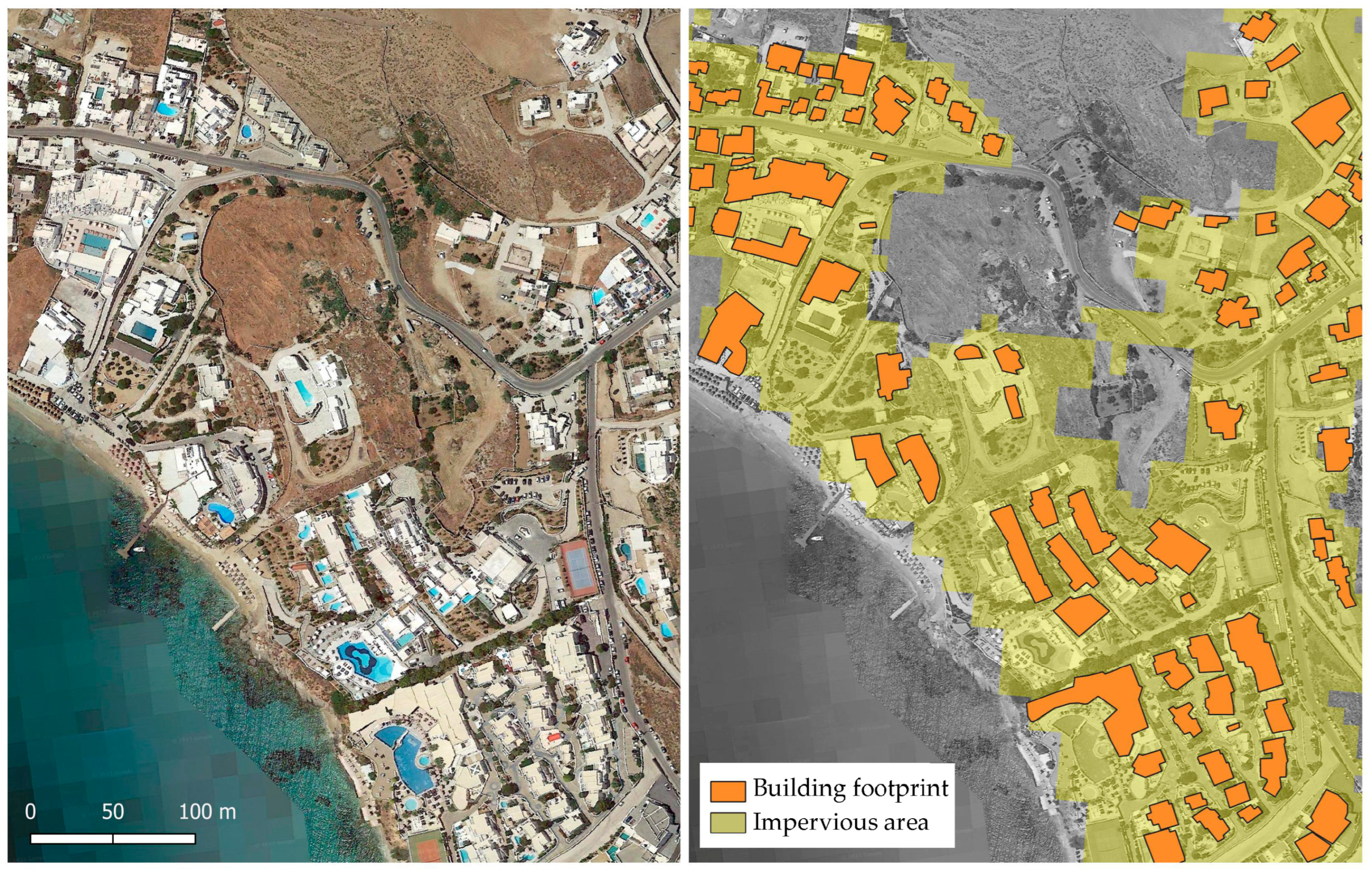
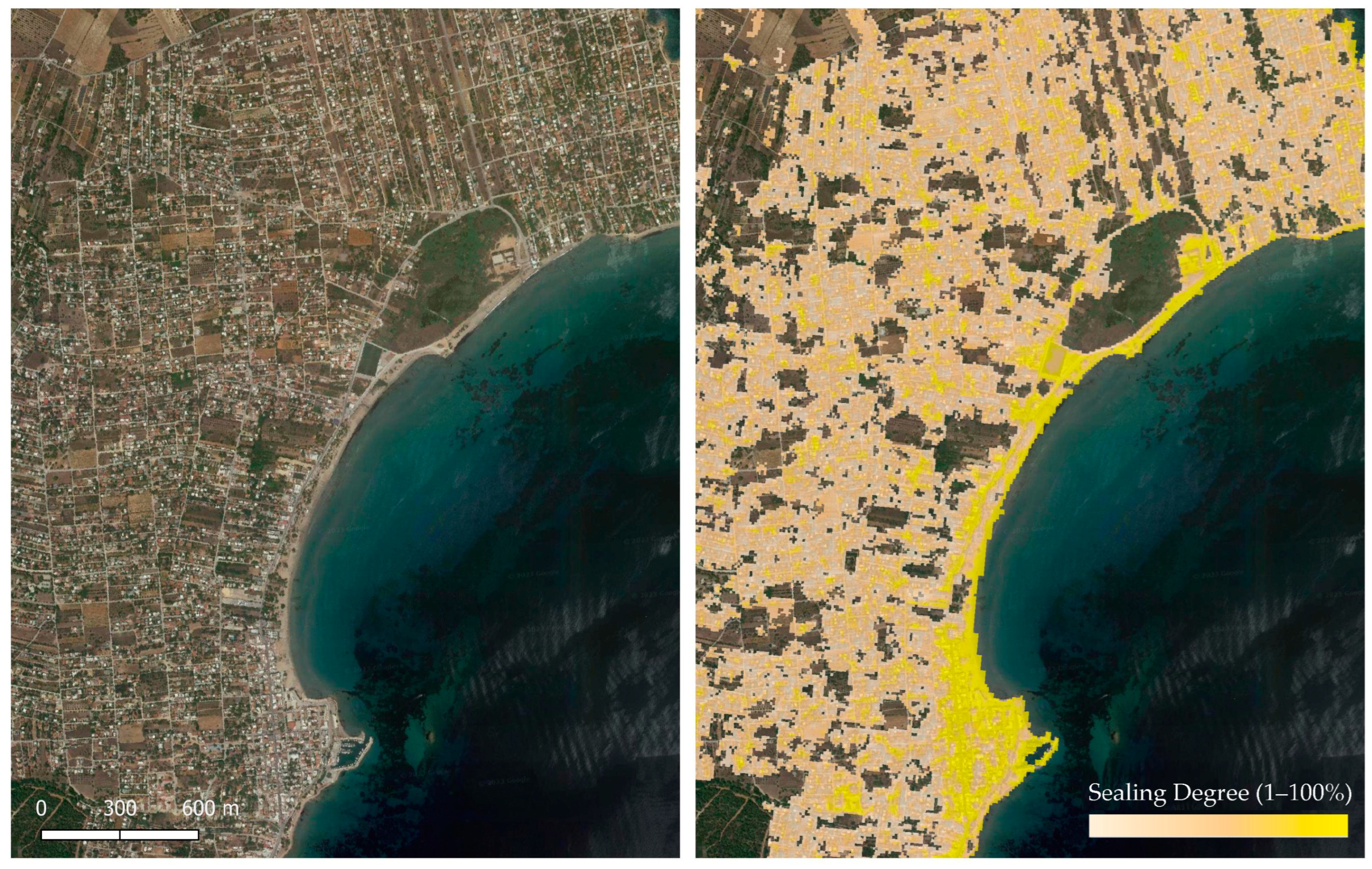
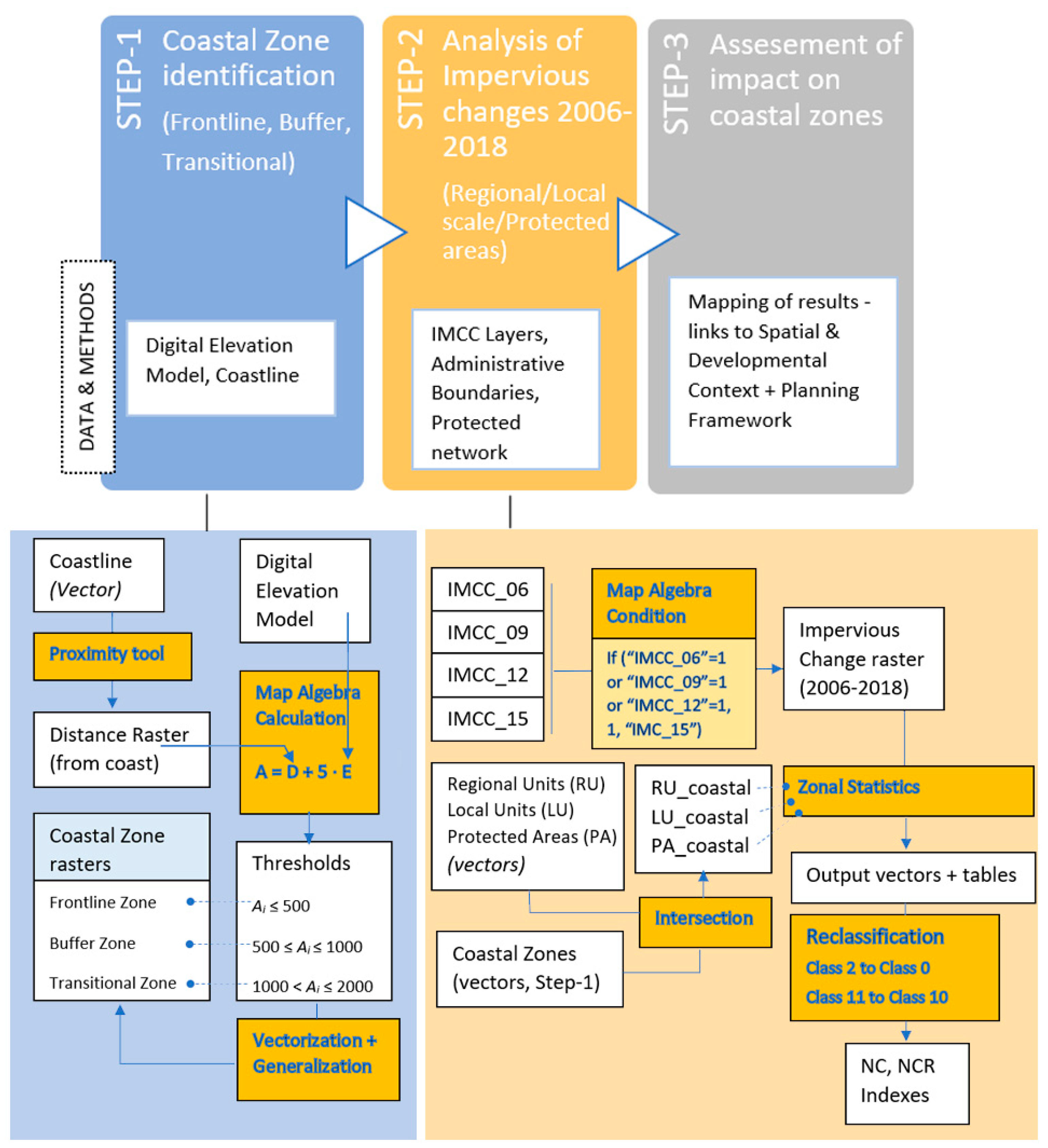
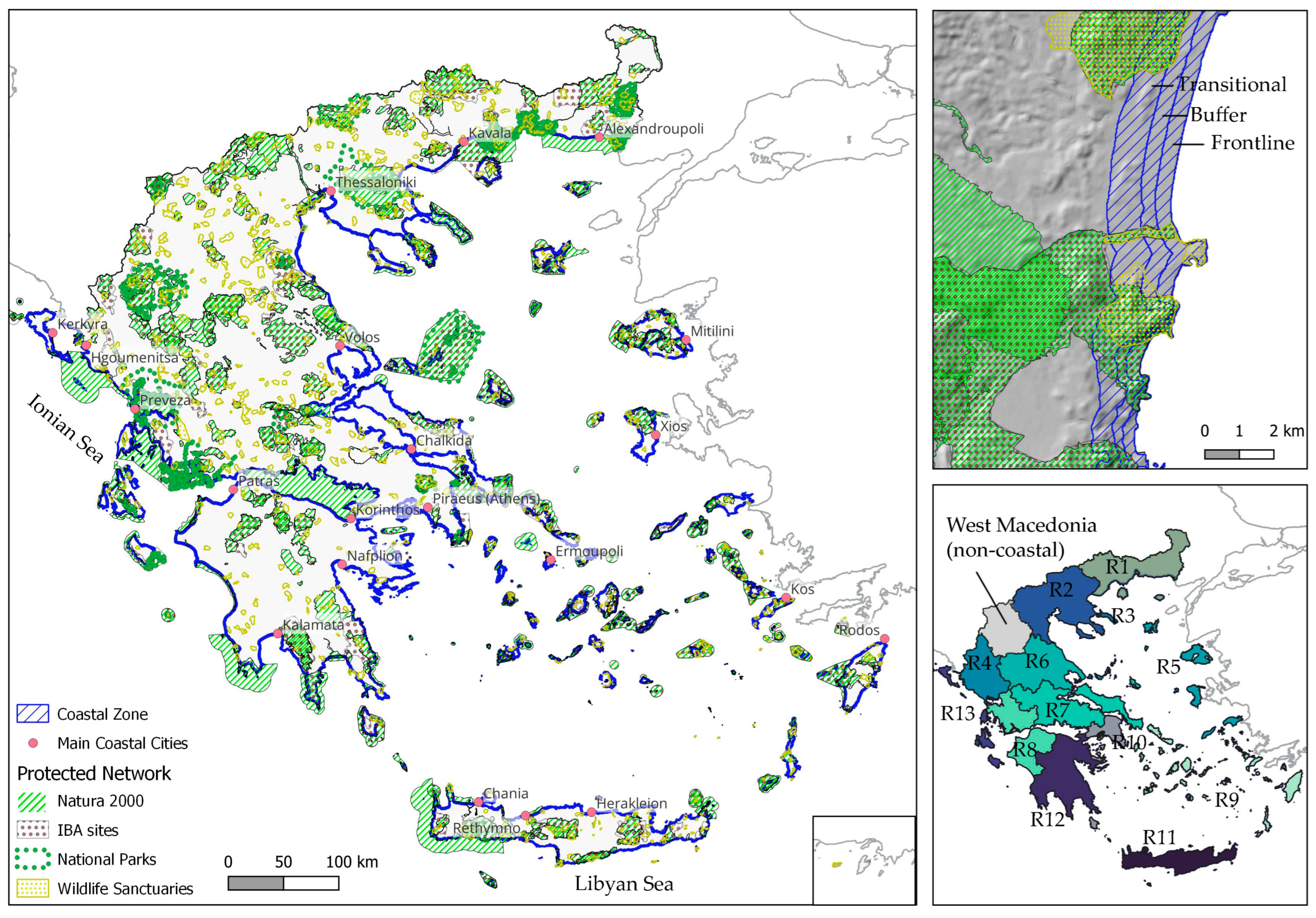
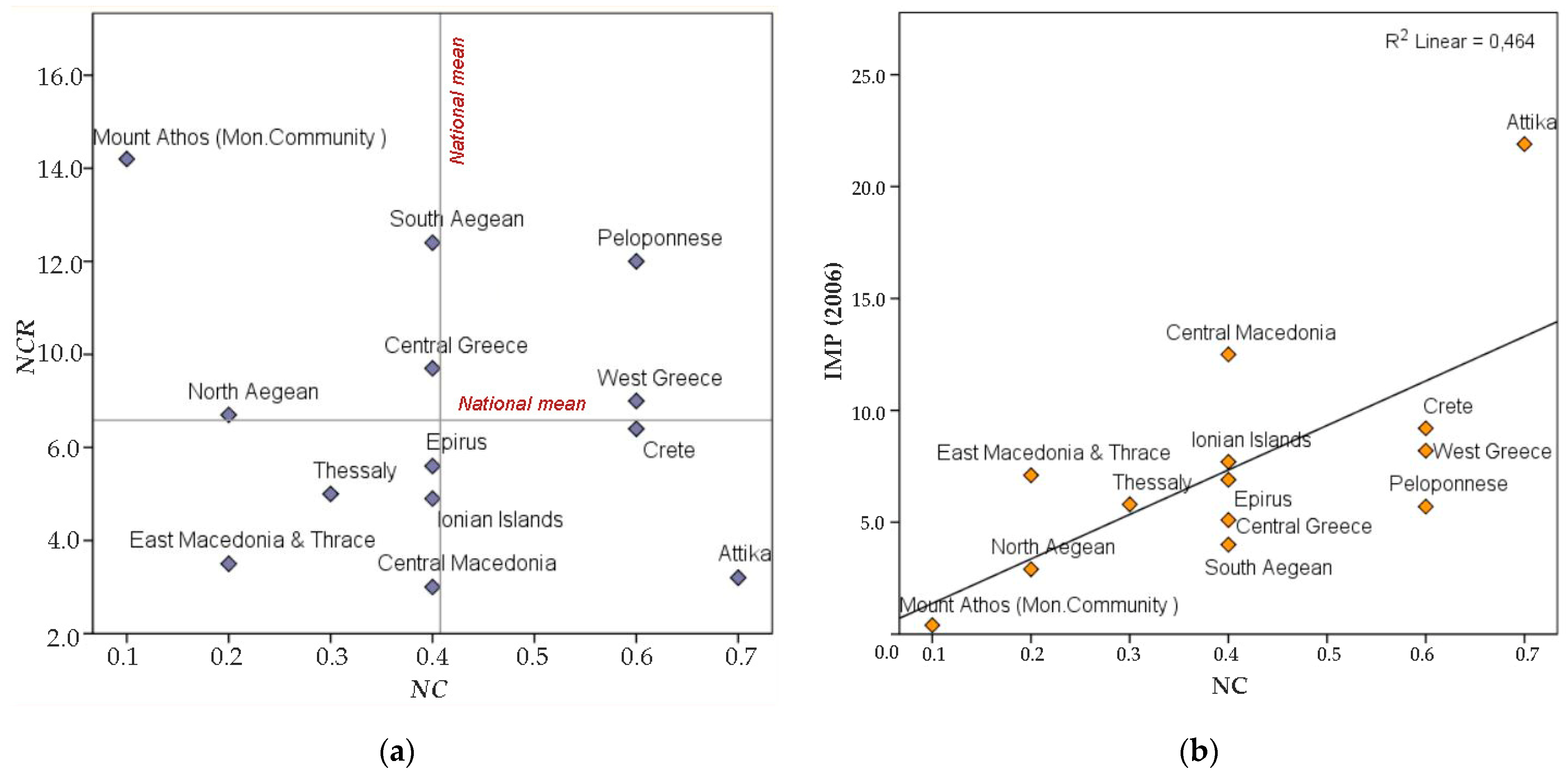
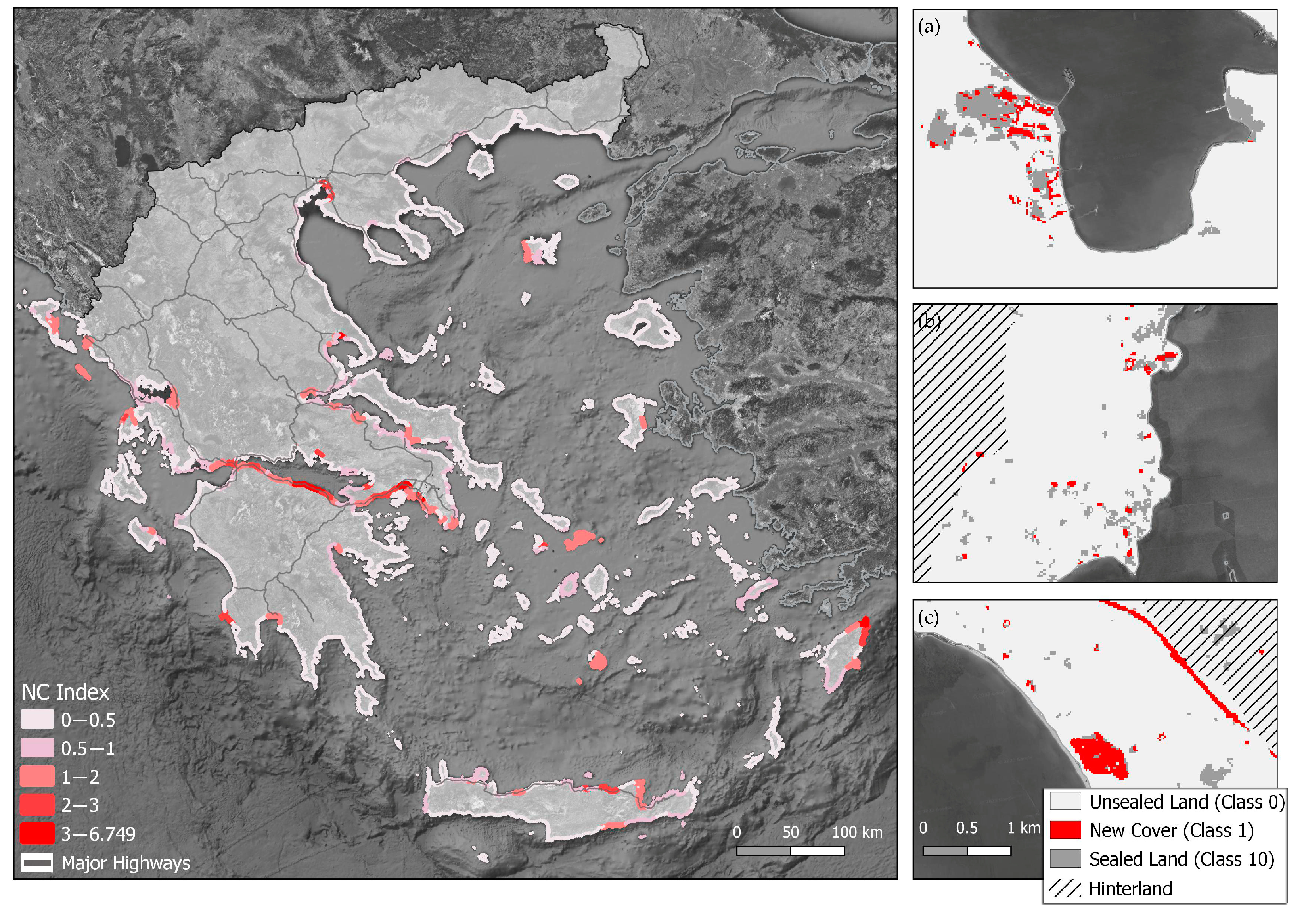
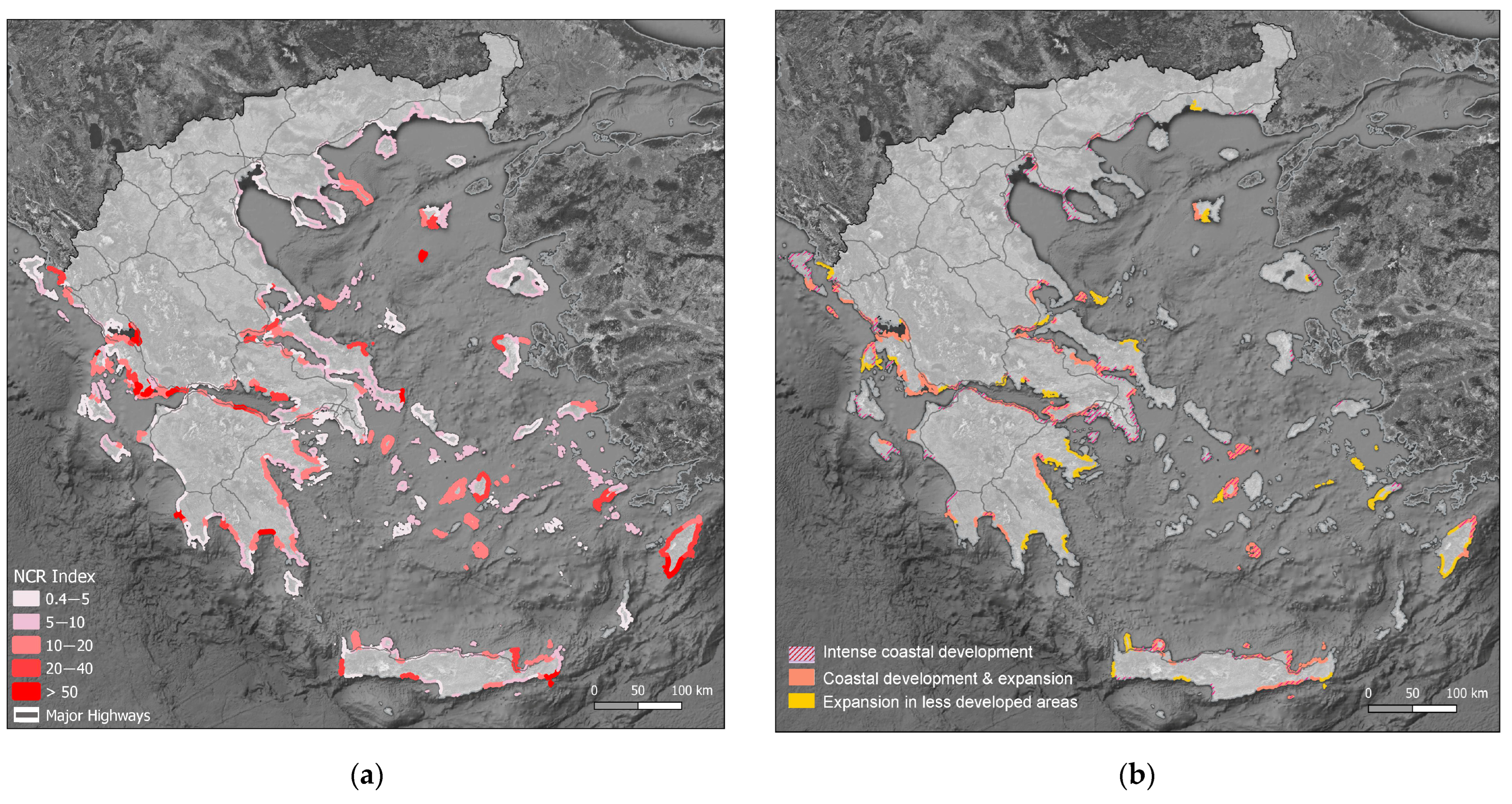
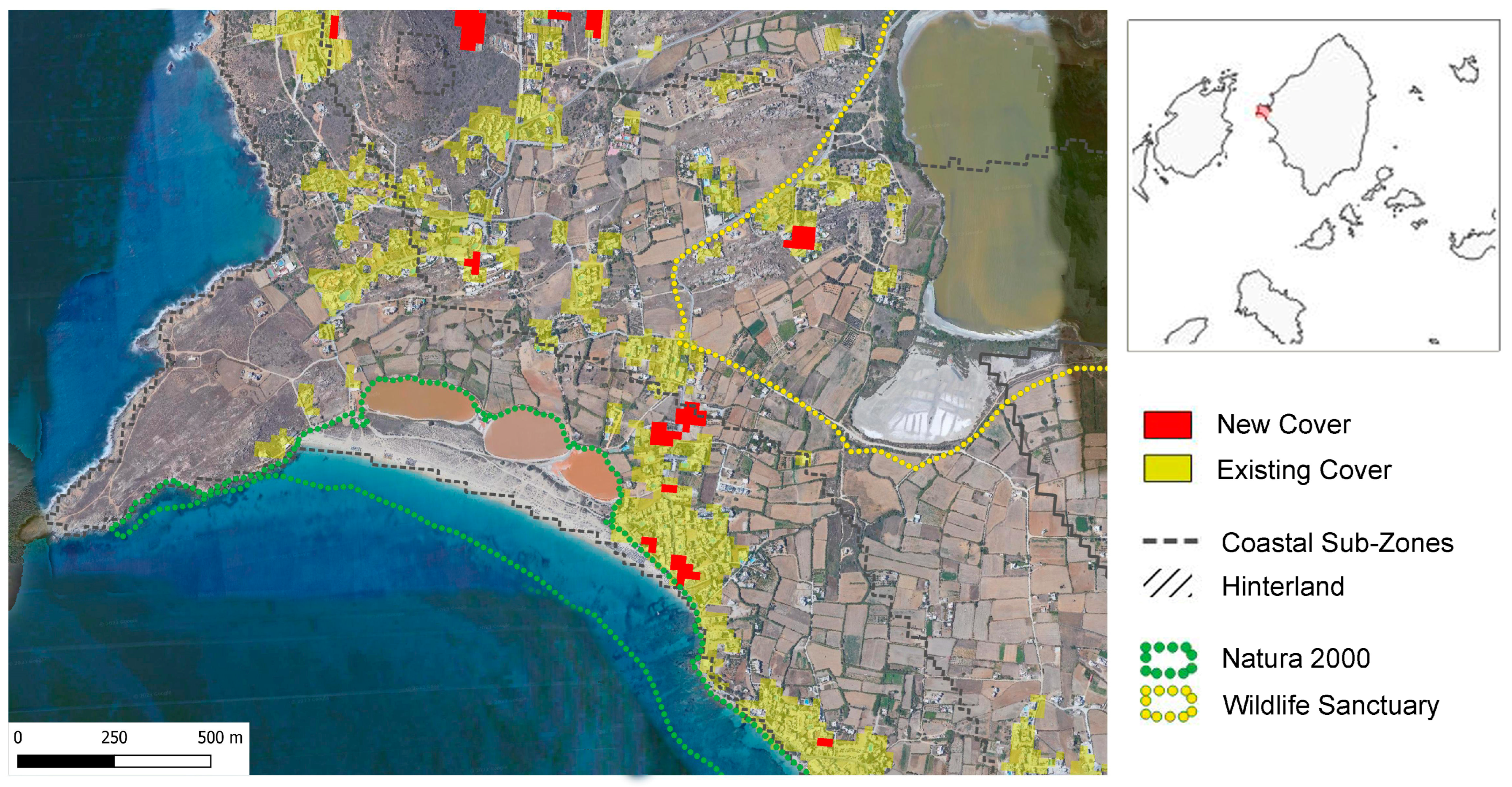
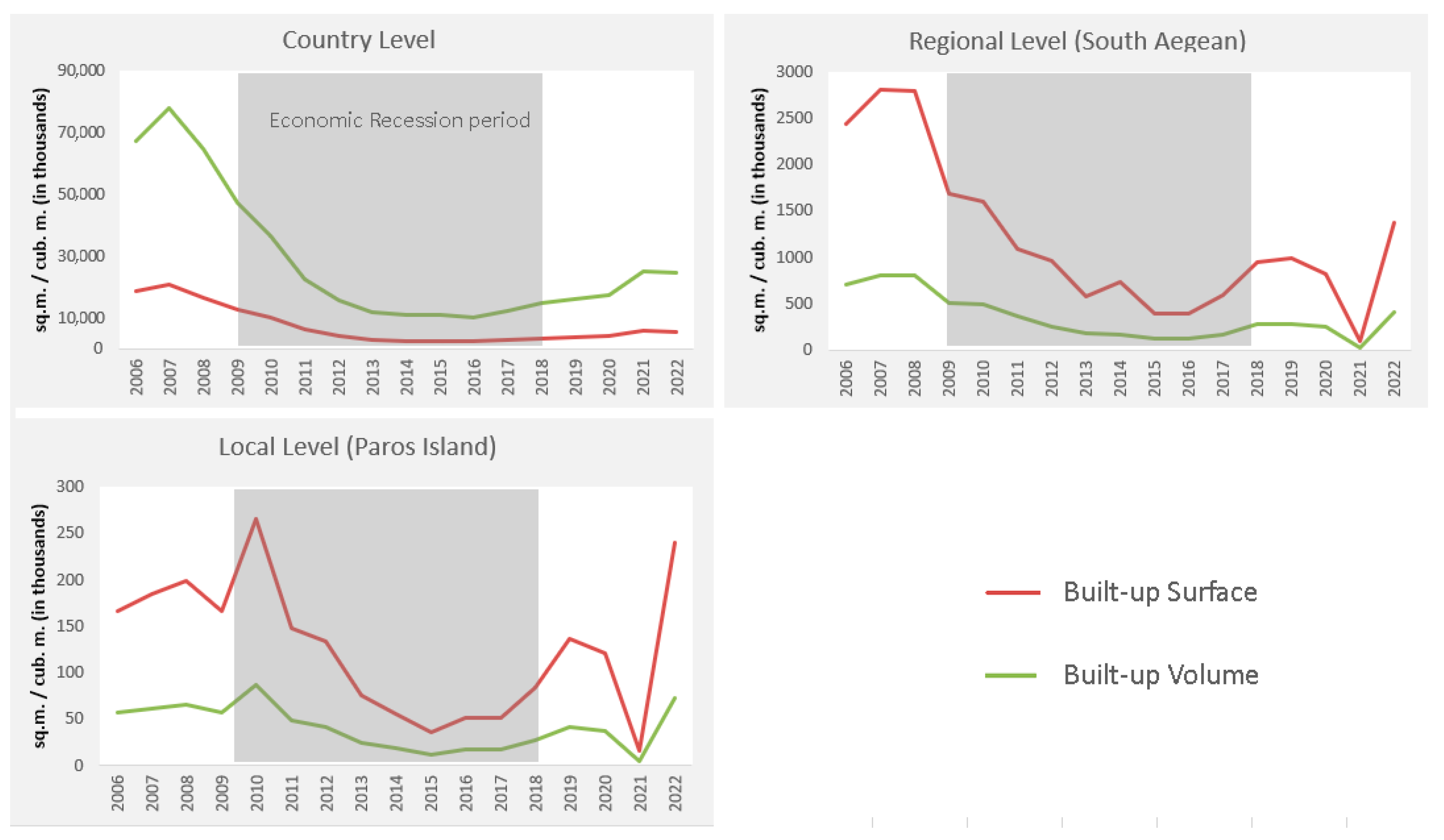
| Region | NC | NCR | % Impervious Land | |||||||
|---|---|---|---|---|---|---|---|---|---|---|
| Z1 * | Z2 * | Z3 * | Z1 | Z2 | Z3 | Z1 | Z2 | Z3 | ||
| R1 | East Macedonia and Thrace | 0.5 | 0.2 | 0.1 | 4.1 | 3.7 | 2.7 | 11.8 | 6.6 | 5.0 |
| R2 | Central Macedonia | 0.6 | 0.3 | 0.3 | 3.5 | 2.4 | 2.9 | 19.4 | 13.8 | 9.1 |
| R3 | Athos (Mon. community) | 0.2 | 0.0 | 0.0 | 12.7 | 20.9 | 10.3 | 1.5 | 0.1 | 0.3 |
| R4 | Epirus | 0.5 | 0.3 | 0.4 | 5.3 | 4.0 | 7.2 | 9.1 | 8.2 | 5.6 |
| R5 | North Aegean | 0.3 | 0.2 | 0.1 | 6.1 | 6.8 | 7.8 | 6.0 | 2.7 | 1.9 |
| R6 | Thessaly | 0.6 | 0.3 | 0.2 | 5.0 | 5.8 | 4.4 | 11.5 | 5.4 | 3.6 |
| R7 | Central Greece | 0.6 | 0.3 | 0.3 | 6.1 | 6.9 | 11.2 | 10.9 | 4.9 | 3.2 |
| R8 | West Greece | 0.6 | 0.6 | 0.5 | 4.9 | 7.1 | 9.4 | 12.8 | 9.2 | 6.3 |
| R9 | South Aegean | 0.6 | 0.3 | 0.3 | 10.4 | 9.7 | 10.9 | 6.9 | 4.0 | 3.1 |
| R10 | Attica | 1.2 | 0.6 | 0.5 | 4.0 | 2.5 | 3.1 | 30.9 | 24.3 | 17.1 |
| R11 | Crete | 1.0 | 0.6 | 0.4 | 6.7 | 5.8 | 6.6 | 16.0 | 10.3 | 6.4 |
| R12 | Peloponnese | 1.0 | 0.6 | 0.3 | 9.4 | 11.4 | 9.6 | 11.2 | 6.1 | 3.8 |
| R13 | Ionian Islands | 0.7 | 0.3 | 0.2 | 5.1 | 4.1 | 5.4 | 15.2 | 7.9 | 4.8 |
| GR | Greece (mean) | 0.7 | 0.4 | 0.3 | 5.9 | 5.4 | 6.2 | 12.5 | 7.7 | 5.3 |
| Region | Protected Area (km2) | % of Coastal Zone | Impervious Expansion (ha) | NCpr * | NCRpr * | % of Protected Land Affected | |
|---|---|---|---|---|---|---|---|
| R1 | East Macedonia and Thrace | 379 | 58.6 | 44.1 | 0.12 | 5.8 | 2.14 |
| R2 | Central Macedonia | 270 | 28.3 | 0.0 | 0.12 | 0.1 | 2.21 |
| R3 | Athos (Mon. community) | 102 | 99.8 | 5.2 | 0.05 | 12.2 | 0.48 |
| R4 | Epirus | 193 | 59.9 | 34.6 | 0.18 | 5.6 | 3.41 |
| R5 | North Aegean | 562 | 47.0 | 64.8 | 0.12 | 9.3 | 1.36 |
| R6 | Thessaly | 213 | 38.6 | 30.8 | 0.14 | 7.4 | 2.10 |
| R7 | Central Greece | 386 | 28.2 | 80.8 | 0.21 | 8.8 | 2.58 |
| R8 | West Greece | 399 | 42.9 | 153.2 | 0.39 | 14.0 | 3.16 |
| R9 | South Aegean | 1246 | 53.5 | 150.6 | 0.12 | 11.8 | 1.14 |
| R10 | Attica | 185 | 21.6 | 46.8 | 0.25 | 4.6 | 5.78 |
| R11 | Crete | 364 | 34.8 | 69.0 | 0.19 | 13.6 | 1.58 |
| R12 | Peloponnese | 387 | 31.0 | 54.0 | 0.14 | 7.8 | 1.92 |
| R13 | Ionian Islands | 247 | 29.1 | 69.1 | 0.28 | 6.4 | 4.65 |
| GR | Greece (mean) | 4933 | 39.8 | 802.9 | 0.17 | 8.6 | 2.14 |
Disclaimer/Publisher’s Note: The statements, opinions and data contained in all publications are solely those of the individual author(s) and contributor(s) and not of MDPI and/or the editor(s). MDPI and/or the editor(s) disclaim responsibility for any injury to people or property resulting from any ideas, methods, instructions or products referred to in the content. |
© 2023 by the author. Licensee MDPI, Basel, Switzerland. This article is an open access article distributed under the terms and conditions of the Creative Commons Attribution (CC BY) license (https://creativecommons.org/licenses/by/4.0/).
Share and Cite
Lagarias, A. Impervious Land Expansion as a Control Parameter for Climate-Resilient Planning on the Mediterranean Coast: Evidence from Greece. Land 2023, 12, 1844. https://doi.org/10.3390/land12101844
Lagarias A. Impervious Land Expansion as a Control Parameter for Climate-Resilient Planning on the Mediterranean Coast: Evidence from Greece. Land. 2023; 12(10):1844. https://doi.org/10.3390/land12101844
Chicago/Turabian StyleLagarias, Apostolos. 2023. "Impervious Land Expansion as a Control Parameter for Climate-Resilient Planning on the Mediterranean Coast: Evidence from Greece" Land 12, no. 10: 1844. https://doi.org/10.3390/land12101844
APA StyleLagarias, A. (2023). Impervious Land Expansion as a Control Parameter for Climate-Resilient Planning on the Mediterranean Coast: Evidence from Greece. Land, 12(10), 1844. https://doi.org/10.3390/land12101844






